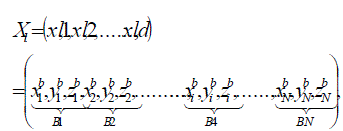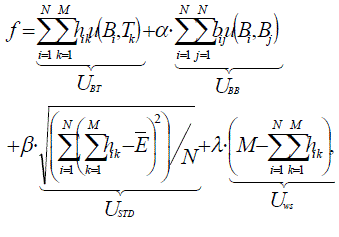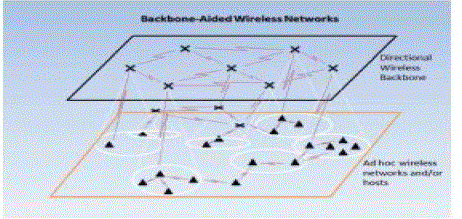Keywords
|
| Hierarchical Heterogeneous Wireless Networks (HHWNs), Flocking Algorithm (FA), Particle Swarm Optimizer (PSO) |
INTRODUCTION
|
| Wireless network refers to any type of computer network that is wireless, and is commonly associated with a telecommunications network whose inter connections between nodes are implemented without the use of wires. Wireless telecommunications networks are generally implemented with some type of remote information transmission system that uses electromagnetic waves, such as radio waves, for the carrier and this implementation usually takes place at the physical level or "layer" of the network. |
| Wireless networks have continued to develop and their uses have grown significantly. Cellular phones are part of huge wireless network systems. People use these phones daily to communicate with one another. Sending information overseas is possible through wireless network systems using satellites and other signals to communicate across the world. Emergency services such as the police department utilize wireless networks to communicate important information quickly. People and businesses use wireless networks to send and share data quickly whether it be in a small office building or across the world. Another important use for wireless networks is as an inexpensive and rapid way to be connected to the Internet in countries and regions where the telecom infrastructure is poor or there is a lack of resources, as in most developing countries. |
| A wireless network is more vulnerable, because anyone can try to break into network broadcasting a signal. Many networks offer WEP - Wired Equivalent Privacy - security systems which have been found to be vulnerable to intrusion. Though WEP does block some intruders, the security problems have caused some businesses to stick with wired networks until security can be improved. Another type of security for wireless networks is WPA - Wi-Fi Protected Access. WPA provides more security to wireless networks than a WEP security set up. The use of firewalls will help with security breaches which can help to fix security problems in some wireless networks that are more vulnerable. |
| Recent advances in directional wireless communications for providing mobile, broadband wireless connectivity are making next generation communication networks increasingly complex. These networks are characterized by hierarchical architectures, with heterogeneous properties and dynamic behaviour. The need for ubiquitous broadband connectivity and the capacity limitation of homogeneous wireless networks is driving communication networks to adopt hierarchical architectures with diverse communication technologies and node capabilities at different layers that provide assured end-to-end broadband connectivity in a wide range of scenarios [5]. As an example illustrated in Fig. 1, backbone based wireless networks use two-tiered network architecture, which consists of a set of flat ad hoc wireless networks and/or hosts as well as a broadband wireless mesh backbone network of higher capability nodes. In this architecture, backbone nodes use directional wireless communications, either Free Space Optical (FSO) or directional Radio Frequency (RF), to aggregate and transport traffic from hosts at lower layers. |
| The most important concern in HHWNs is to assure network coverage and backbone connectivity in dynamic wireless environments. |
| The new main contributions of this paper are threefold. First, a nonconvex model for topology control in HHWNs where the minimization of the potential energy function is subject to real-world physical constraints. Second, a new FA is used to self-organize the backbone network at the upper layer in order to adapt to changing environments and minimize the system’s energy. Third, PSO algorithms to solve the global optimization problem using hybrid fitness function. |
Network Control Model
|
| A new HHWN control model, which considers real-world physical constraints, is introduced. First, a constrained optimization problem is formulated. Then a convex model is described, which does not consider real-world physical constraints. Two nonconvex models: 1) a Morse potential force driven model involving power limitation constraints; and 2) a new hybrid energy model that takes into account both power limitations as well as distance threshold constraints. |
Convex Model
|
| Without taking into account the physical constraints θ, Llorca et al. [3] introduced an iterative approach to solve the optimization problem described in (9). They reported that when assuming no physical constraints this is a convex problem, which can be solved by using gradient descent-based methods. A force-based algorithm is used to dynamically relocate the backbone nodes in order to jointly optimize coverage and connectivity. Then, the location of backbone nodes (B1, B2, . . ., BN) is updated until the location change || Bi(t) - Bj(t-1)||reaches the predefined resolution or the maximum number of iterations is reached. This algorithm is referred to as the Attraction Force Driven algorithm (AFD). |
Nonconvex Model
|
| This nonconvex force model is used to develop an adaptive control strategy, where communication links are retained or released based on their cost in the network. As opposed to the AFD algorithm derived from the convex model, where links are always retained, the adaptive algorithm developed allows the release of connections when the distance, or more precisely communications cost is too high. This algorithm is referred as the Morse Force Driven (MFD) algorithm, which shows a significant improvement in the average number of Source-to-Destinations (SD) maintained, as compared to AFD. |
Flocking Algorithm
|
| Recall that the objective in HHWNs is to optimize the total energy cost of the system while guaranteeing end-to-end communications with physical constraints. The problem has been transformed to relocate the positions of backbone nodes. |
Flocking Rules
|
In this model, each backbone node represents an agent in a flock. A terminal node Tk(s) is assumed to be stationary during the movement of backbone nodes because of a time delay, which is consistent with practical situations. Here, s represents the time series of the terminal node dynamics. Thus, time t ∈ [0, tmax] with respect to backbone nodes is a subinterval of [s – 1, s] with respect to terminal nodes. A backbone node i at time t is characterized by its location Bi (t) associated with the real coordinates  and its force vector υi (t). Let bij (t) and hik (t) be the link assignment variables for backbone-to-backbone links and backbone-to-terminal links at time t, respectively. The forces acting on backbone node i include: and its force vector υi (t). Let bij (t) and hik (t) be the link assignment variables for backbone-to-backbone links and backbone-to-terminal links at time t, respectively. The forces acting on backbone node i include: |
| • Survival force. The “survival force” makes a backbone node try to maintain connection to those terminal nodes it had covered at the last time period s-1. |
| • Repulsion force. The “repulsion force” is produced by three sources: terminal nodes covered by the backbone node i at the bottom layer in HHWNs, neighbor backbone nodes connected to backbone node i at the upper layer, and the terrain. |
• Retention force. The “retention force” is produced by two sources and it is calculated where,  sta denotes the statement sta denotes the statement  denotes the statement denotes the statement  is another distance threshold between backbone nodes and terminal nodes and kij is a coefficient that considers the effect of sharing the load between backbone nodes, where Rj is the capacity of the backbone node j. is another distance threshold between backbone nodes and terminal nodes and kij is a coefficient that considers the effect of sharing the load between backbone nodes, where Rj is the capacity of the backbone node j. |
Release force. The “release force” is used to consider the effect of power limitation, which is controlled by a distance threshold  Here, consider only the release force between backbone nodes and terminal nodes because a large power between backbone nodes is usually available in practice to assure the connectivity at the upper layer. Where, Here, consider only the release force between backbone nodes and terminal nodes because a large power between backbone nodes is usually available in practice to assure the connectivity at the upper layer. Where,  denotes the statement denotes the statement  |
Particle Swarm Optimizer
|
| The topology control problem in HHWNs can be effectively formulated as an energy minimization problem whose solution jointly optimizes coverage and connectivity in dynamic environments. The use of global information is expected to produce better solutions at the expense of longer convergence time and scalability limitations. In HHWNs, the solution is the location of the backbone nodes (B1,B2,…,BN) that minimizes the total energy of the system while satisfying real-world physical constraints. A stack vector to encode particle l as Xl = (xl,1, xl,2, . . . , xl,d) is used in the following way: |
 (1) (1) |
| Where d =3N is the dimension size that each particle explores in this optimization problem. |
 (2) (2) |
Where  is the average number of terminal nodes connected to a backbone node. The first term UBT is the total energy cost for network coverage as described and the second term UBB is the total energy cost for backbone connectivity. The third term USTD is the standard deviation of the number of terminal nodes connected to a backbone node which characterizes the distribution of backbone-to-terminal connections per backbone node. Finally, the term ULOS is the number of lost connections or number of terminals not connected to any backbone node. α are weighting parameters, whereas parameter is a large number used to increase the weight on the Loss of Connections (LC) cost. is the average number of terminal nodes connected to a backbone node. The first term UBT is the total energy cost for network coverage as described and the second term UBB is the total energy cost for backbone connectivity. The third term USTD is the standard deviation of the number of terminal nodes connected to a backbone node which characterizes the distribution of backbone-to-terminal connections per backbone node. Finally, the term ULOS is the number of lost connections or number of terminals not connected to any backbone node. α are weighting parameters, whereas parameter is a large number used to increase the weight on the Loss of Connections (LC) cost. |
Drawbacks of Existing System
|
| Two biology-inspired techniques are used for the Hierarchical Heterogeneous Wireless Networks (HHWNs) management. They are Flocking Algorithm (FA) and Particle Swarm Optimizer (PSO). Nonconvex mathematical model is initiated for HHWN control and optimization. Flocking Algorithm (FA) is tuned for self-organization and control of the backbone nodes in an HHWN. Local information from end users are used in the FA based model. Flocking Algorithm (FA) is used to deliver optimized dynamic network behavior. Particle Swarm Optimizer (PSO) algorithm directly optimize the HHWN by collecting global information from the entire system. |
| • HHWN stability is not managed |
| • Channel assignment is not optimized with high node mobility |
| • Limited backbone node management process |
| • Node mobility and scalability are not managed in dynamic environment |
PROPOSED SYSTEM
|
| The stability management process integrated with the system with dynamic update intervals. Undesired weather events, geographic conditions, and information capacity of each agent factors violates the stability of the network. Local information based agent movement is not sufficient for the stability management. Global information is used to manage the stability issues. |
| PSO model is applied with multiple agent movement process. Node mobility affects the channel allocation process. Periodical update is called for the backbone nodes. The terminal node connects the host with backbone node. network connectivity requires global information updates. Terminal node and backbone node energy levels are not controlled in dynamic conditions. Energy optimization is required for the terminal and backbone nodes. Terminal node assignment is planned with energy levels. |
| The system is designed to manage HHWN under dynamic network conditions. The system is divided into six modules. |
HHWN Initialization
|
| The hierarchical heterogeneous wireless network is initialized with a set of nodes. The base station is placed to manage nodes. The base station is placed with fixed coverage and bandwidth value. |
Node Management
|
| The backbone nodes and terminal nodes are used in the system. The backbone node is used to manage the communication between the base station and terminal nodes. The terminal nodes are the end user nodes. The terminal node communication is managed by the back bone nodes. |
Power and Link Analysis
|
| The energy level for backbone nodes are used in the terminal node assignment process. The energy level is reduced with reference to the terminal node communications. The connectivity between the backbone nodes and base station are used in the link analysis. Link between the backbones nodes are also used in the link analysis process. |
Network Control with FA
|
| The network control operations are initiated to assign terminal nodes. Local information is used in the flocking algorithm for terminal node assignment. Backbone node and its terminal node details are used in the local analysis process. |
Network Control with PSO
|
| The global information based network controlling is used in the system. The PSO algorithm is used in the global analysis process. Backbone and terminal node details for entire network are used in the global analysis. Node location, count and bandwidth availability details are used in the global analysis. |
Enhanced Network Control
|
| The enhanced network control model is designed to handle dynamic conditions. Node mobility is updated periodically. Backbone nodes reassign the terminal nodes with current node information. |
Figures at a glance
|
 |
| Figure 1 |
|
References
|
- Haijun Zhang, Jaime Llorca, Christopher C. Davis, Milner, “Nature-Inspired Self- Organization, Control, and Optimization in Heterogeneous Wireless Networks” IEEE Transactions on Mobile Computing, Vol. 11, No. 7, July 2012.
- J. Llorca, S.D. Milner, and C.C. Davis, “Molecular System Dynamics for Self-Organization in Heterogeneous Wireless Networks,” EURASIP J. Wireless Comm. and Networking, in press, 2010.
- S.D. Milner, J. Llorca, and C.C. Davis, “Autonomous, Reconfiguration and Control in Directional Mobile Ad Hoc Networks,” IEEE Circuits and Systems Magazine, vol. 9, no. 2, pp. 10-26, Apr.-June 2009.
- C.C. Davis, Z. Haas, and S. Milner, “On How to Circumvent the MANET Scalability Curse,” Proc. IEEE Military Comm. Conf. (MILCOM), 2006.
- C.C. Davis, I.I. Smolyaninov, and S.D. Milner, “Flexible Optical Wireless Links and Networks,” IEEE Comm. Magazine, vol. 41, no. 3, pp. 51- 57, Mar. 2003.
- J. Llorca, M. Kalantari, S.D. Milner, and C.C. Davis, “A Quadratic Optimization Method for Connectivity and Coverage Control in Backbone- Based Wireless Networks,” J. Ad Hoc Networks, vol. 7, pp. 614-621, 2009.
- J. Llorca, S.D. Milner, and C.C. Davis, “A Convex Optimization Method for Autonomous Self-Organization in Dynamic Wireless Networks,” Proc. IEEE Military Comm. Conf. (MILCOM), Nov. 2008.
|